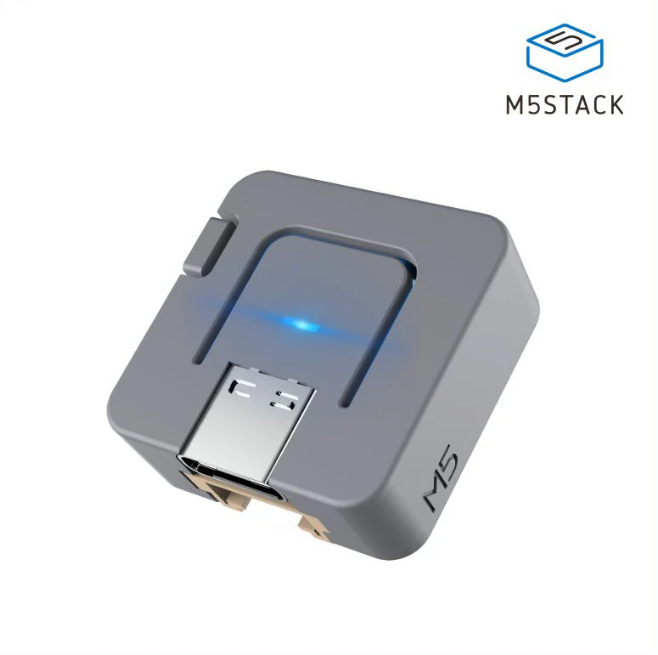I had good experience with using the M5Stack Atom Matrix devices in my Water Watcher project. With a 5x5 grid of RGB LEDs, there are lots of possibilities for displaying feedback, and the entire face of the device is a large button that can be pushed to signal something. For this project, I still need a pushable button, but I only need a couple bits of feedback: has the button been pushed, and is the recirculation pump still active. I decided to use M5Stack Atom Lite devices for this project. They are much more compact than anything I would likely create myself. They have an ESP32 and are powered via USB-C. They have a large button on the face and a single RGB LED. They have several other features that I don't need for this project.

I expect to deploy at least two of these in upstairs bathrooms, and it's possible I will sprinkle one or two more at other locations. I wanted all of the feedback to go to all of the devices, and I also wanted to know reliably that the button press had the desired effect. For those reasons, the button press is detected by Home Assistant, and Home Assistant controls the RGB LED.
The button press is simple to configure in ESPHome and is readily detected as a trigger by Home Assistant. The RGB LED control takes a little bit more work. I defined three services on the Atom: set_led_hot, set_led_cold, and set_led_off. That abstracts the device behavior from Home Assistant's intentions when it calls the services. Each service just calls a script to do something with the RGB LED. The Atom boots up as "cold" and is typically in that state. The RGB LED emits a soft and steady blue. The "hot" display is orange-yellow and blinking. The "off" display is obvious, though I don't currently have a use for it. All of the colors, brightness values, and blinking behavior were set by trial and error to get something I liked.
I split the ESPHome configuration into two pieces. One piece has the device-specific information (node name and API encryption key), and the ESPHome "include" feature is used to combine that with a common file that is the same for all of the devices.
One of the device-specific pieces:
substitutions:
node_name: hotbuttonkb
api_key: !secret hotbuttonkb_apikey
<<: !include { file: hotbutton.yaml.inc}
The common file:
esphome:
name: $node_name
on_boot:
then:
# delay to allow other boot time stuff to settle down
- delay: 5s
- script.execute: set_led_cold
esp32:
board: pico32
wifi:
networks:
- ssid: !secret wifi_ssid
password: !secret wifi_password
sensor:
- platform: wifi_signal
name: ${node_name} WiFi Signal
logger:
level: DEBUG
ota:
password: !secret ota_password
api:
encryption:
key: ${api_key}
reboot_timeout: 60min
services:
- service: set_led_hot
then:
- logger.log:
tag: 'hotbutton'
level: INFO
format: "service: set_led_hot"
- script.execute: set_led_hot
- service: set_led_cold
then:
- logger.log:
tag: 'hotbutton'
level: INFO
format: "service: set_led_cold"
- script.execute: set_led_cold
- service: set_led_off
then:
- logger.log:
tag: 'hotbutton'
level: INFO
format: "service: set_led_off"
- script.execute: set_led_off
binary_sensor:
- platform: gpio
pin:
number: GPIO39
inverted: true
name: ${node_name} Button
id: big_button
internal: false
light:
- platform: fastled_clockless
id: bright_light
name: ${node_name} LED
chipset: SK6812
pin: GPIO27
num_leds: 1
rgb_order: GRB # required
default_transition_length: 0s
effects:
- pulse:
name: fast_pulse
transition_length: 0.25s
update_interval: 0.25s
min_brightness: 20%
max_brightness: 99%
script:
- id: set_led_hot
then:
- light.turn_on:
id: bright_light
red: 100%
green: 60%
blue: 0%
effect: fast_pulse
- id: set_led_cold
then:
- light.turn_on:
id: bright_light
color_brightness: 20%
red: 0%
green: 0%
blue: 100%
effect: none
- id: set_led_off
then:
- light.turn_on:
id: bright_light
color_brightness: 0%
red: 0%
green: 0%
blue: 0%
effect: none
 WJCarpenter
WJCarpenter
Discussions
Become a Hackaday.io Member
Create an account to leave a comment. Already have an account? Log In.